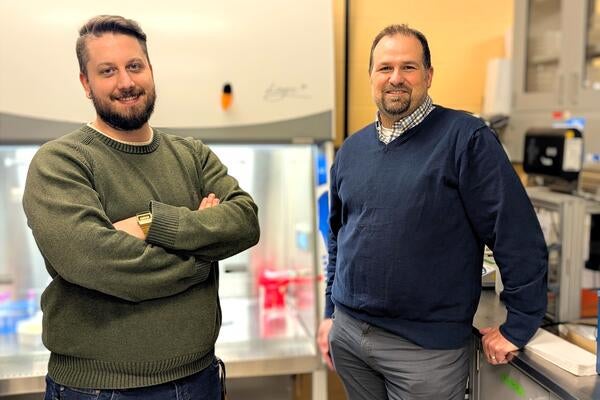
Eco ink writes new chapter for graphene use
Waterloo researchers develop 3D-printable graphene ink for widespread health, industrial and environmental applications

Waterloo researchers develop 3D-printable graphene ink for widespread health, industrial and environmental applications
By Media RelationsResearchers at the University of Waterloo have unlocked the potential of graphene in areas as diverse as vehicles, consumer electronics and environmental cleanup with an eco-friendly ink for 3D-printing.
Graphene is well known for its strength, electrical conductivity and thermal properties, but it is typically produced in a powder form that can be difficult to work with, therefore limiting its uses.
Waterloo researchers tackled that problem by creating the world’s first all-graphene ink by engineering graphene nanosheets that can disperse in water while still maintaining conductivity.

A 3D printer uses the graphene ink to make a UW logo (University of Waterloo)
In addition to extreme versatility, the new ink is environmentally friendly because it is additive-free and, unlike alternatives, does not require any chemical solvents for printing.
“Shaping graphitic materials into complex geometries for advanced applications has long been a critical challenge that has limited their widespread adoption,” said Dr. Milad Kamkar, a professor in the Department of Chemical Engineering at Waterloo. “With our proposed methods, we can 3D-print graphene into any shape.”
As a water-based, functional ink, graphene can be used with 3D printers to make sensors for smartwatches and fitness bands, or glucose monitoring for people with diabetes.
Other potential applications include 3D-printed parts to make vehicles lighter, reducing fuel consumption while also improving durability, and filters to purify and even desalinate water.

Chemical Engineering PhD student Shakiba Samsami loading the graphene ink into the 3D printer. (University of Waterloo)
Graphene ink could also be used in batteries, printed electronics and environmental remediation, such as cleaning up oil spills in oceans with porous, super-absorbent structures, and capturing carbon dioxide in the atmosphere to help minimize climate change.
To devise these inks, the research team – which included members from the University of Calgary, the University of British Columbia and Aalto University in Finland – developed a two-step electrochemical process that is well-suited to mass-manufacturing.
A specially designed step called intercalation, which involves the insertion of a molecule into layered graphite, allows for continuous production of the graphene nanosheets in water.
“Our modern technological advancements have come at the cost of new environmental challenges,” said Kamkar, who is also director of the Multiscale Materials Design Lab at Waterloo.
“To survive and address these challenges, we must develop new materials that are more effective than those currently available. This can only be achieved by controlling and fine-tuning material properties across multiple scales, from the molecular and nano levels to the macro scale.”
The researchers’ next steps will involve exploring advanced applications for environmental remediation and carbon dioxide capture technology.
The study, Additive-free graphene-based inks for 3D printing functional conductive aerogels, appeared in Journal of Materials Chemistry A.

Read more
Engineering researchers team up to tackle the plastics pollution problem with microbial innovation and engineering design

Read more
15 University of Waterloo researchers have been named to the annual Highly Cited Researchers™ list for significant contributions to their specific fields of research

University of Waterloo Engineering master's student Liam Salass developed an AI-based system that improved puck detection when analyzing game video. (University of Waterloo)
Read more
University of Waterloo researchers make big strides in hockey analysis using game video
The University of Waterloo acknowledges that much of our work takes place on the traditional territory of the Neutral, Anishinaabeg, and Haudenosaunee peoples. Our main campus is situated on the Haldimand Tract, the land granted to the Six Nations that includes six miles on each side of the Grand River. Our active work toward reconciliation takes place across our campuses through research, learning, teaching, and community building, and is co-ordinated within the Office of Indigenous Relations.